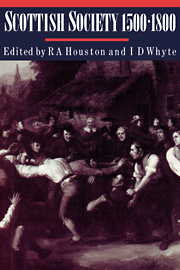Book contents
- Frontmatter
- Contents
- List of tables
- Notes on contributors
- List of abbreviations
- Introduction: Scottish society in perspective
- 1 Population mobility in early modern Scotland
- 2 Scottish food and Scottish history, 1500–1800
- 3 Continuity and change in urban society, 1500–1700
- 4 Women in the economy and society of Scotland, 1500–1800
- 5 Social responses to agrarian ‘improvement’: the Highland and Lowland clearances in Scotland
- 6 ‘Pretense of blude’ and ‘place of thair dwelling’: the nature of highland clans, 1500–1745
- 7 North and south: the development of the gulf in Poor Law practice
- 8 Scotland and Ireland, 1600–1800: their role in the evolution of British society
- 9 Kindred adjoining kingdoms: an English perspective on the social and economic history of early modern Scotland
- Bibliography of printed sources and secondary works
- Index
3 - Continuity and change in urban society, 1500–1700
Published online by Cambridge University Press: 08 March 2010
- Frontmatter
- Contents
- List of tables
- Notes on contributors
- List of abbreviations
- Introduction: Scottish society in perspective
- 1 Population mobility in early modern Scotland
- 2 Scottish food and Scottish history, 1500–1800
- 3 Continuity and change in urban society, 1500–1700
- 4 Women in the economy and society of Scotland, 1500–1800
- 5 Social responses to agrarian ‘improvement’: the Highland and Lowland clearances in Scotland
- 6 ‘Pretense of blude’ and ‘place of thair dwelling’: the nature of highland clans, 1500–1745
- 7 North and south: the development of the gulf in Poor Law practice
- 8 Scotland and Ireland, 1600–1800: their role in the evolution of British society
- 9 Kindred adjoining kingdoms: an English perspective on the social and economic history of early modern Scotland
- Bibliography of printed sources and secondary works
- Index
Summary
INTRODUCTION
The 150 years after 1500 saw the reshaping of urban society in Scotland. There was in the last quarter of the sixteenth century a significant recovery in the level of exports after a slump which had lasted since the early fourteenth century. A series of political crises, beginning with the Reformation, brought the burghs to an unaccustomed position at the front of the political stage. That, in turn, encouraged unprecedented interference in burgh affairs by central government and a much more co-ordinated urban voice in national politics, with the emergence in the 1550s of the Convention of Royal Burghs as the regular assembly for the commissioners of the chartered towns. Those towns and their townspeople had, in common with the rest of Scottish society, experienced modest demands for revenue from Scotland's medieval kings. From the 1530s onwards they were confronted by spiralling tax bills, which brought into the tax net sectors of the urban population previously exempt; one of the most striking differences between urban society in 1500 and 1650 was the dramatic increase in its taxpaying sector. There was in the same period (as in much of northern Europe), a significant if usually unquantifiable rise in the population of towns. There was probably no increase in the proportion of the Scottish people living in towns. But this growth was important for its impact on urban society, as it was the first significant rise in population for fully three centuries. It is difficult to believe that the combined effect of these novel pressures, which were mostly concentrated in the second half of the sixteenth century, left the social fabric of the medieval burgh community undisturbed.
- Type
- Chapter
- Information
- Scottish Society, 1500–1800 , pp. 85 - 117Publisher: Cambridge University PressPrint publication year: 1989
- 4
- Cited by



